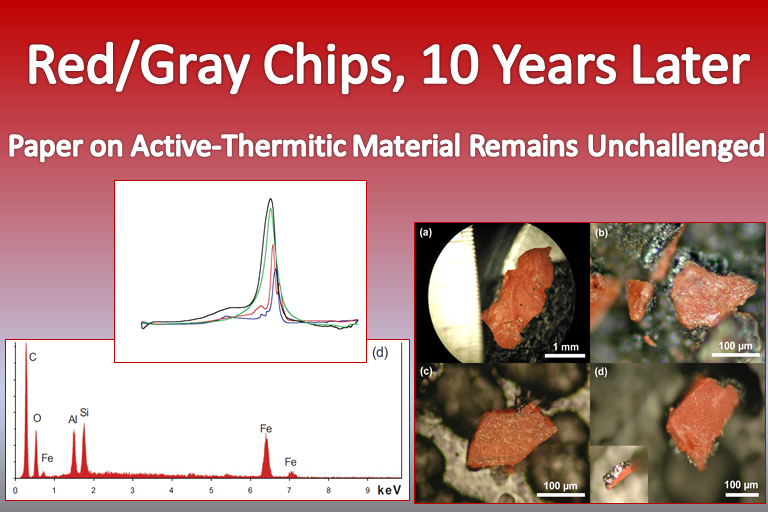What's Going On
Latest Newsletter
|
|
|||
|
|||
| Click here to view the Newsletter online | |||

|
|||
| Saturday, October 05, 2019 | www.911tap.org | |
|||
Red/Gray Chips, 10 Years LaterRed/Gray Chips, 10 Years Later; Paper on Active-Thermitic Material Remains Unchallenged
April 3, 2019 marked the tenth anniversary of the publication of the landmark paper, "Active Thermitic Material Discovered in Dust from the 9/11 World Trade Center Catastrophe," by Dr. Niels H. Harrit, along with Dr. Steven Jones, chemist Kevin Ryan and others. This is one of the key scientific studies that was ignored by the FBI’s 9/11 Review Commission, which underscores the need for a court-overseen review of the 9/11 related evidence that was not included in the 2004 9/11 Commission Report. This study is so significant that it was included as Exhibit 1 of the Department of Justice Grand Jury Petition filed with the office of the U.S. Attorney in Manhattan, New York, by The Lawyers’ Committee for 9/11 Inquiry. Over the last decade, it has mostly been criticized in the blog-o-sphere. There was one attempt by James R. Millette, Ph.D., Executive Director of MVA Scientific Consultants, to develop a technical paper refuting the findings of Harrit et al, but upon receiving feedback from his preliminary draft report, the project was abandoned and the analysis was not rehabilitated. Because Millette's preliminary draft study has been used by many in the blog-o-sphere, who have limited technical competency, a discussion of some of the shortcomings, with the Millette report, is included as an addendum. OverviewAn investigative team, originally lead by Dr. Stephen Jones and Jeff Farrer, discovered distinctive red/gray chips in samples of the dust produced by the destruction of the World Trade Center. Detailed examination of the chips was then performed by a larger group of experts. They examined four samples of dust that had been collected from separate sites and reported the results in their paper, "Active Thermitic Material Discovered in Dust from the 9/11 World Trade Center Catastrophe." One sample was collected by a Manhattan resident about ten minutes after the collapse of the second WTC Tower, two the next day, and a fourth about a week later.  Figure 1: Photomicrographs of red/gray chips from samples 1-4 of the WTC dust involved in this study, shown in (a)-(d) respectively. The inset in (d) shows the chip edge on, which reveals the gray layer. Click image to enlarge. Naked-eye and microscopic examination revealed numerous tiny metallic, magnetically attracted, spheres and quite distinctive red/gray chips in the dust samples. The properties of the red/gray chips shown in Figure 1 were analyzed using Optical Microscopy, Scanning Electron Microscopy (SEM), X-ray Energy Dispersive Spectroscopy (XEDS), and Differential Scanning Calorimetry (DSC). The red material contains grains approximately 100 nano-meters across, which are largely iron oxide, while aluminum is contained in tiny plate-like structures. Separation of components using methyl ethyl ketone demonstrated that elemental aluminum is present. The iron oxide and aluminum are intimately mixed in the red material. When ignited in a DSC, the chips exhibit a large, narrow exothermic event occurring at approximately 430 °C. The ignition temperature is far below the normal ignition temperature for commercial thermite which consists of large particles of iron and aluminum that have significant distances between the elements (on an atomic scale) . The paper notes that numerous iron-rich spheres are clearly observed in the residue following the ignition of these peculiar red/gray chips. The red portion of these chips is found to be an unreacted highly energetic thermitic material. This article briefly summarizes some of the tests presented in the paper. Please consult the paper, or the videos below, for a more complete discussion. X-ray Energy Dispersive Spectroscopy (XEDS)X-ray Energy Dispersive Spectroscopy is an analytical technique used for the elemental analysis or chemical characterization of a sample. This test relies on the interaction of a narrow beam of X-rays with the atoms in a sample. The characterization capabilities result from the fundamental principle that each element has a unique atomic structure creating a distinct pattern of energy absorption and re-emission as the atoms are excited by x-rays with varying amounts of energy. This process allows identification of the presence of specific atoms in a very precise area. |
|||
Upcoming Events
|
|||
Help us help you achieve a new independent, comprehensive Congressional investigation.The 9/11 Truth Action Project (9/11 TAP) is a new organization that grew out of the aspirations for grassroots action expressed by several previous 9/11 Truth groups. 9/11 TAP’s mission is to build and mobilize a global grassroots movement to create a groundswell of civic support that achieves transparency and accountability for the crimes of 9/11, justice for its victims, an end to unwarranted wars, and restoration of our civil liberties.
The goal of this new movement is to achieve an independent, comprehensive Congressional investigation, by mobilizing and coordinating the efforts of volunteers across the U.S. and abroad, through local Truth Action Groups coordinated at the state, regional, national and international levels. |
|||
|
If you no longer wish to receive this Newsletter click here to unsubscribe |
|||
10/05/2019
Actions
9/11 TAP in the Social Media












 Subscribe to RSS Feed
Subscribe to RSS Feed Active Thermitic Red / Gray Chips 10 Years Later
Active Thermitic Red / Gray Chips 10 Years Later





